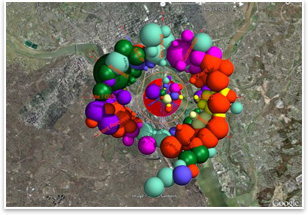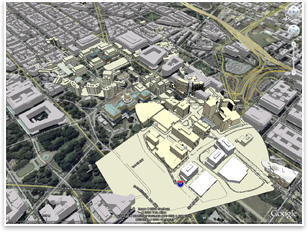| |
BIMStorm Settles Over Alexandria, Va.
Designers and clients get together in person and over the Web to take on the city’s future
by Zach Mortice
Associate Editor
 How do you . . . foster increased multidisciplinary stakeholder participation in a Web-based BIM design format? How do you . . . foster increased multidisciplinary stakeholder participation in a Web-based BIM design format?
Summary: The BIMStorm Alexandria (Va.) conference in September allowed designers, clients, and others involved in the building process to contribute designs and information via a Web-based system that accepts data from many different software types and integrates it all in a building modeling format. These data were applied to real sites targeted for redevelopment by the City of Alexandria and local developers. A primary development issue in Alexandria will be the closure of military facilities, and the city is hoping the BIMStorm event will give them strategies for attracting new federal government agencies to take over these sites.
A virtual model of a historic and changing suburb across the river from the nation’s capital took shape last week, populated by site redevelopment plans, 3D models, infrastructural inventories, and programmatic data. The Alexandria Economic Development Partnership and Onuma, Inc, which provided the event’s software and format, sponsored the conference.
Stretching BIM technology
BIMStorm Alexandria, Va., was facilitated by building information modeling (BIM) technology that has been stretched far beyond its use as a single building modeling tool. Even as BIM was expanded to deal with design at a masterplanning level, Onuma’s computer program facilitated civic and community input from stakeholders without technical design knowledge, effectively increasing the scale of BIM design capabilities while decreasing the threshold of technical design ability required to use it. The key to this is the Onuma Planning System (OPS), developed by Kimon Onuma, FAIA. OPS is an open standard system that allows users to interact via the Internet and populate BIM designs with data from programs as simple as Excel and Google Earth, which allows unprecedented participation and interaction across the entire spectrum of the building process.
 “Everyone comes in with their tool set and we use our system as a model server, which kind of stitches everything together,” Onuma says. “Basically, it’s BIM on the Web.” “Everyone comes in with their tool set and we use our system as a model server, which kind of stitches everything together,” Onuma says. “Basically, it’s BIM on the Web.”
Web-based tool makes it possible
And because Onuma’s system is completely Web-based, he was able to pull in 40 participants who worked with the models virtually, over the Internet, in addition to the 60 or so people who brought their laptops to the Alexandria Westin. Because it de-emphasizes the need for stakeholders to congregate in one spot, Onuma (whose own Pasadena, Ca.-based architecture practice has half of its employees work from remote locations) calls it “low-carbon collaboration.”
Onuma and his firm have been using BIM since 1994, and OPS began to take shape around 2000 as he looked for a way to coordinate the work of his IT and computer science-savvy architects spread across the world.
For a month before the Alexandria BIMStorm, Onuma worked with city officials and developers to highlight real sites in Alexandria slated for redevelopment, collect background data, and train participants to use OPS through Webinars. On September 10 and 11, teams of architects, developers, specialty consultants, builders, engineers, and civic officials met and collaborated to address future land use and development issues. A panel of three judges (including former AIA President RK Stewart, FAIA), will give awards to participants for urban planning, security, sustainability, and more within the next month.
 The collaborators The collaborators
The participation of city leaders and developers meant that BIMStorm Alexandria would have real-world repercussions beyond laptop computers and screen shots. “Up until now, we’ve been doing BIMStorms that have been more or less theoretical,” Onuma says. “They weren’t real projects, and it’s really exciting to be here in Alexandria looking at real-world scenarios.”
One development reality the city is grappling with through the BIMStorm conference is the closure of military facilities, which in Alexandria are mostly commercial office spaces. The city will lose 7,200 jobs by 2011 and will need to redevelop 5-10 million square feet of office space.
- Michael Chipley, the city’s Base Realignment and Closure Coordinator, says the city is looking to attract new federal government entities to these sites. The federal government has placed serious emphasis on sustainability by encouraging LEED certification, and dense, transit-oriented development, as well as requiring new building designs to be formatted in BIM. Chipley, who approached Onuma about bringing the BIMStorm to Alexandria, says that balancing these factors with the need for high levels of security and quality design is aided by the collaborative nature of the OPS and BIM system because of its non-linear process.
- Anita Bullock, of the landscape architecture firm EDAW, came to the BIMStorm to look at how to redevelop a site called Land Bay H for a potential General Services Administration government campus. Bullock says that a primary challenge for this project is to balance the security needs appropriate for a federal agency (like controlled circulation and isolation setbacks) with the desire for quality-designed, dense, public transit-oriented places. “That mix is opposed to each other a lot of the time,” she says.
- Rich Josephson, Alexandria’s Deputy Planning Director, says he hopes BIM can help the city execute this synthesis of sustainability, design, and security better. “We’re looking at this as an opportunity or potential tool that could be used to enhance what we already do,” he says.
- A designer specializing in research and code specifications with WDG Architecture, Deborah MacPherson, Assoc. AIA, came to the BIMStorm to look for ways to standardize codes across various levels of state and municipal government. She praised OPS for allowing non-designers to have more robust input into the building process.
- Evelyn Nash, of the sustainability consultant Cadmus Group, says the multidisciplinary aspects of OPS-enabled building modeling provide particular bonuses to the process of designing eco-friendly buildings. “To get any kind of sustainability or environmental efforts addressed, usually it takes months and months,” she says. “With this, it gets the ball rolling so you can work out the little nuances in the beginning.”
- Besides preparing for the loss of jobs in Alexandria, teams were also focused on how best to co-opt the addition of jobs to nearby areas. Across the Potomac River from Alexandria, the National Harbor in Maryland now contains a massive entertainment and hotel masterplan, and Michael Casey, an engineering professor at George Mason University, investigated how to incorporate a ferry service from the harbor into Alexandria. As a design educator, Casey says BIM technology has made a fundamental impact on his job. “It changes design so it’s all model-based,” he says.
An emerging democracy
By allowing simultaneous input from so many levels, Onuma sees what went on in Alexandria and has gone on at other BIMStorms as part of a continual democratization of design and information. All it takes is a willingness to share information and an understanding that the model of architecture as the pursuit of a single “mater-of-puppets auteur” is no longer applicable. “The more you horde information, the less we want to work with you,” he says. “If you try to close things down, that’s when errors start happening. By making it transparent, you can see problems faster, too. A lot of business practices have been about: ‘What do we protect and not share with the outside world?’ If you look at business models that have developed on the Internet, it’s the reverse, so we’re flipping it around.”
|
|


 How do you . . .
How do you . . . “Everyone comes in with their tool set and we use our system as a model server, which kind of stitches everything together,” Onuma says. “Basically, it’s BIM on the Web.”
“Everyone comes in with their tool set and we use our system as a model server, which kind of stitches everything together,” Onuma says. “Basically, it’s BIM on the Web.” The collaborators
The collaborators